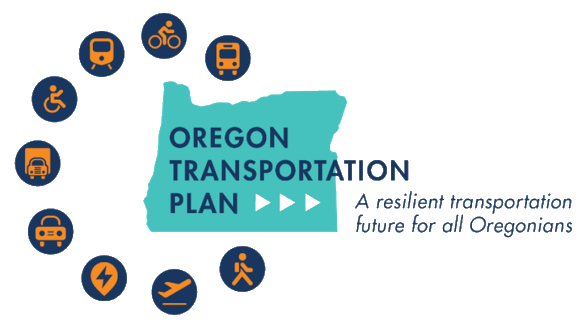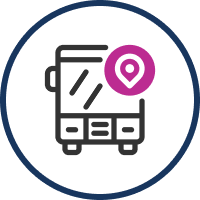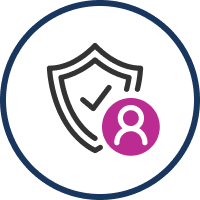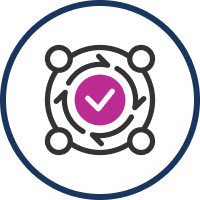
Welcome to The Oregon Transportation Plan!
Review our plan goals, explore the draft plan and provide comments, and test your knowledge on the planning process.
Review Our GoalsOur Goals.
Thanks to everyone who helped develop the draft Oregon Transportation Plan (OTP) over the last two years, especially community members across the state who provided feedback via our online open houses, surveys, committee meetings and focus groups. We gathered input on a variety of topics including what is most important to you in your daily travels. We used this feedback to develop goals and policies. And now the draft OTP is ready for your review and comments now through May 12. To learn more about the plan and how to share your feedback during the public comment period, visit the project website.
Review the Draft OTPTest your Knowledge!
Updating the OTP provides an opportunity to create a more sustainable and equitable transportation system that gets all Oregonians where they’re going safely and efficiently. And planning for the future of transportation is going to take tradeoffs and compromise. From aging tunnels and bridges to congested roadways to missing sidewalks and bikeways, investments are needed across the multimodal system to address all these issues. Take this short quiz to see how much you know about transportation planning!
Question 1 The Oregon Transportation Plan guides investments by providing...
Incorrect.
The Oregon Transportation Plan sets the vision for all the ways people and goods move, including walking, biking, rolling, public transit, highways, railroads, freight, and even planes. From major bridge improvements to local sidewalk projects, an updated Oregon Transportation Plan will guide transportation investments for the whole state over the next 25+ years.
Question 2 Tradeoffs and compromise are a natural part of transportation investment decisions because...
Incorrect.
The hard truth is that planning for the future of transportation is going to take tradeoffs and compromise. Funding is limited, and we are going to need to prioritize and balance investments and consider options for more sustainable funding to meet needs all over the state.
Many of our state’s key transportation structures, such as tunnels and bridges, are 50 to 80 years old and are becoming less safe and operational. In some areas of the state, traffic comes to a standstill, impacting the ability to get goods to market and deliveries to people’s homes. In addition to repair and congestion on roadways, there are many areas of the state where people cannot get to their destination by biking, walking, or rolling because sidewalks and bikeways are missing. Investments are needed across the multimodal system to address all of these issues, but there is not enough funding to fully meet all of these needs.
This update to the Oregon Transportation Plan is an opportunity to outline priorities for statewide transportation funding and policies. It's going to take sustained action at state and local levels to implement the policies in the plan and create a better transportation future.
Question 3 Funding for transportation is limited because...
Incorrect.
Today, a good portion of Oregon’s funding for road preservation and improvement projects comes from road users through fuel tax, weight-mile tax and vehicle registrations. These funding sources are not sustainable because they are largely dependent on gas sales, which have been declining for over a decade and will decline more as vehicles become more efficient. At the same time, the cost of doing business has increased substantially and there have been very few changes to the proportion of fees people pay. Spending is quickly outpacing the money coming in. It is important to find alternative funding streams, which may include tolling and pay-per-miles-driven programs.
Question 4 How much does an Oregon driver pay per gallon of gas into the transportation system per year versus our neighbors in WA, CA, ID?
Incorrect.
Oregon drivers pay approximately $0.62 per gallon into the Oregon transportation system, whereas in Washington it is $1.77, in California $1.71, and in Idaho $0.87. In Oregon, other than the privilege tax on the sale price of each vehicle sold in Oregon, all motorist taxes and fees are dedicated to roads. In some of our neighboring states, motorist revenues are used to support non-highway/transit programs.
Question 5 Transportation planning is different today than 20 years ago because...
Incorrect.
All these listed, and many more, make transportation planning different today than it was 20 years ago. Key trends that are changing the way we move around include:
- Oregon's population has grown over 20% since 2000, and we expect continued growth.
- Contributing factors behind increased traffic congestion in urban and rural areas, including increased demand for goods and growth in tourism.
- Technology that is changing the way people and goods move around.
- Climate change impacts on our communities and natural resources.
- Widening disparities in access to safe and convenient transportation across race, income, age, and other characteristics.
We are considering these changes as part of the Oregon Transportation Plan update to ensure that the policies created are resilient to Oregon’s changing future and help propel us towards the outcomes Oregonians desire.
Question 6 Why does planning for the future of transportation matter?
Incorrect.
One reason the Oregon Transportation Plan matters is because transportation is connected to many other aspects of life. Access to safe, reliable, and convenient transportation also affects our access to jobs, education, healthcare, childcare, food, housing, leisure activities and more. Because it's connected to so much, our transportation system has major implications for social equity, economic health and our ability to bounce back from natural disasters, and it has a huge impact on climate change. Today, about 40 percent of Oregon's total greenhouse gas emissions come from transportation.
On a more personal level, transportation is about movement — something we all can relate to. Almost everyone can think of a meaningful transportation experience in their lives, whether that's the first time riding a bike, or meeting someone new on the bus, or seeing the world a little differently from a window of an airplane.
In other words, transportation plays a big part in shaping our lives, and this plan shapes transportation. Updating the plan gives us a chance to create a more sustainable and equitable transportation system that gets all Oregonians where they're going safely and efficiently — and maybe even a little more joyfully. Planning for a better transportation future is a complex challenge that's going to take collaboration, compromise, and creativity on local and statewide levels.
You got: 0 out of 6 correct!
SharePlanning for transportation over the next two decades is complex, and tradeoffs are inevitable, as funding is limited. But don't despair! Though there will be limitations in our ability to meet all of the needs, we can still find shared priorities and invest in outcomes that serve Oregonians for generations to come. Share this quiz with your friends!
We anticipate completing the Oregon Transportation Plan in 2023. If you are interested in continuing to follow along, sign up for our email list.
Explore the Draft Plan
You are invited to review the draft OTP and provide comments now through May 12.
Explore the Draft PlanDon’t have time to go through the full draft OTP?
View a particular chapter by clicking one of the buttons below.
Chapter 1 Introduction
Provides an overview to the plan’s contents, its significance in transportation planning, and how the plan was developed.
View Chapter 1Chapter 2 Key Drivers of Change
Reviews the “key drivers” that are influencing Oregon’s transportation system users in the coming year such as, population growth, emerging technologies, funding, climate change, and equity.
View Chapter 2Chapter 3 Oregon's Transportation System
Summarizes key elements of transportation in Oregon such as, infrastructure, bicycle and pedestrian safety, freight, and public transportation.
View Chapter 3Chapter 4 Vision of Values
Describes Oregon’s ideal future and the values that will shape policy. It is broken into five goals: mobility, safety, sustainability and climate action, economic vitality and livability, and stewardship of public resources.
View Chapter 4Chapter 5 Policy Framework
Outlines the direction and focus areas across policies in the OTP update which include: saving lives, centering equity, reducing green house gas emissions, securing sustainable and reliable transportation funding, maintaining the existing system and completing critical connections, and enabling the efficient movement of goods and services.
View Chapter 5Chapter 6 Goals, Objectives, Policies and Strategies
Expands on the plans goals and outlines the objectives, policies, and strategies for each.
View Chapter 6Chapter 7 Implementation and Investment Strategies
Summarizes roles and responsibilities, key coordination activities, transportation planning consistency actions that implement the OTP, key performance indicators, and investment and policy outcome scenarios.
View Chapter 7Learn More
Live Webinar
A recording of the webinar is now available on the project website’s Community Engagement page.
Ways to Comment
Online Comment Form
Oregon Transportation Plan Comment Submission
Virtual Public Hearing
Wednesday, May 3, 2023
10:00 a.m.
Visit the project webpage for more information.







